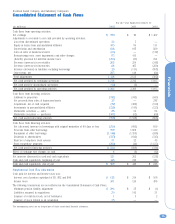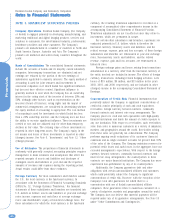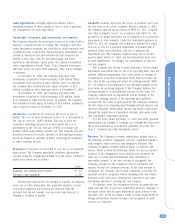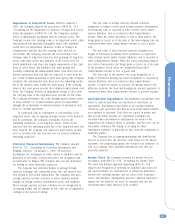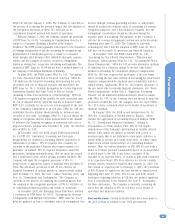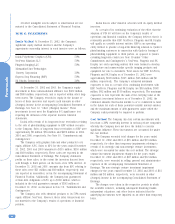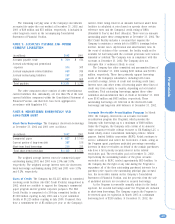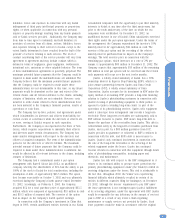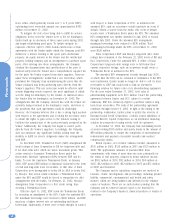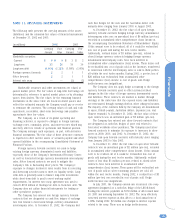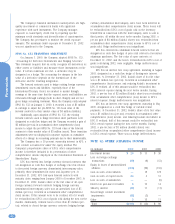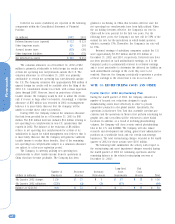Kodak 2002 Annual Report Download - page 52
Download and view the complete annual report
Please find page 52 of the 2002 Kodak annual report below. You can navigate through the pages in the report by either clicking on the pages listed below, or by using the keyword search tool below to find specific information within the annual report.
Financials
52
All other intangible assets subject to amortization are not
material to the Consolidated Statement of Financial Position.
NOTE 6: INVESTMENTS
Equity Method At December 31, 2002, the Company’s
significant equity method investees and the Company’s
approximate ownership interest in each investee were as follows:
Kodak Polychrome Graphics (KPG) 50%
NexPress Solutions LLC 50%
Phogenix Imaging LLC 50%
Matsushita-Ultra Technologies
Battery Corporation 30%
Express Stop Financing (ESF) 50%
SK Display Corporation 34%
At December 31, 2002 and 2001, the Company’s equity
investment in these unconsolidated affiliates was $382 million
and $360 million, respectively, and is reported within other long-
term assets. The Company records its equity in the income or
losses of these investees and reports such amounts in other
(charges) income in the accompanying Consolidated Statement of
Earnings. See Note 12, “Other (Charges) Income.” These
investments do not meet the Regulation S-X significance test
requiring the inclusion of the separate investee financial
statements.
Kodak sells certain of its long-term lease receivables relating
to the sale of photofinishing equipment to ESF without recourse
to the Company. Sales of long-term lease receivables to ESF were
approximately $9 million, $83 million and $397 million in 2002,
2001 and 2000, respectively. See Note 10, “Commitments and
Contingencies.”
The Company sells graphics film and other products to its
equity affiliate, KPG. Sales to KPG for the years ended December
31, 2002, 2001 and 2000 amounted to $315 million, $350 million
and $419 million, respectively. These sales are reported in the
Consolidated Statement of Earnings. The Company eliminates
profits on these sales, to the extent the inventory has not been
sold through to third parties, on the basis of its 50% interest. At
December 31, 2002 and 2001, amounts due from KPG relating to
these sales were $31 million and $40 million, respectively, and
are reported in receivables, net in the accompanying Statement of
Financial Position. Additionally, the Company has guaranteed
certain debt obligations of KPG up to $160 million, which is
included in the total guarantees amount of $345 million at
December 31, 2002, as discussed in Note 10, “Commitments and
Contingencies.”
The Company also sells chemical products to its 50% owned
equity affiliate, NexPress. However, these sales transactions are
not material to the Company’s results of operations or financial
position.
Kodak has no other material activities with its equity method
investees.
As a result of its continuing evaluation of the effect that the
adoption of FIN 46 will have on the Company’s results of
operations and financial condition, the Company believes that it is
reasonably possible that ESF, NexPress, Phogenix and SK Display
will qualify as variable interest entities. ESF is an operating
entity formed to provide a long-term financing solution to Qualex’s
photofinishing customers in connection with Qualex’s leasing of
photofinishing equipment to third parties, as opposed to Qualex
extending long-term credit (see Note 10 under “Other
Commitments and Contingencies”). NexPress, Phogenix and SK
Display are each operating entities that were formed to develop,
manufacture and commercialize specific imaging products and
equipment for sale to customers. Total assets for ESF, NexPress,
Phogenix and SK Display as of December 31, 2002 were
approximately $520 million, $171 million, $25 million and $6
million, respectively. The Company’s estimated maximum
exposures to loss as a result of its continuing involvement with
ESF, NexPress, Phogenix and SK Display are $63 million, $148
million, $42 million and $110 million, respectively. The maximum
exposures to loss represent the sum of the carrying value of the
Company’s investment balances as of December 31, 2002, the
estimated amounts that Kodak intends to or is committed to fund
in the future for each of these potential variable interest entities
and the maximum amount of debt guarantees under which the
Company could potentially be required to perform.
Cost Method The Company also has certain investments with
less than a 20% ownership interest in various private companies
whereby the Company does not have the ability to exercise
significant influence. These investments are accounted for under
the cost method.
The Company recorded total charges for the years ended
December 31, 2002 and 2001 of $45 million and $15 million,
respectively, for other than temporary impairments relating to
certain of its strategic and non-strategic venture investments,
which were accounted for under the cost method. The strategic
venture investment impairment charges for the years ended
December 31, 2002 and 2001 of $27 million and $12 million,
respectively, were recorded in selling, general and administrative
expenses in the accompanying Consolidated Statement of
Earnings. The non-strategic venture investment impairment
charges for the years ended December 31, 2002 and 2001 of $18
million and $3 million, respectively, were recorded in other
(charges) income in the accompanying Consolidated Statement of
Earnings.
The charges were taken in the respective periods in which
the available evidence, including subsequent financing rounds,
independent valuations, and other factors indicated that the
underlying investments were impaired on an other than temporary
basis.



